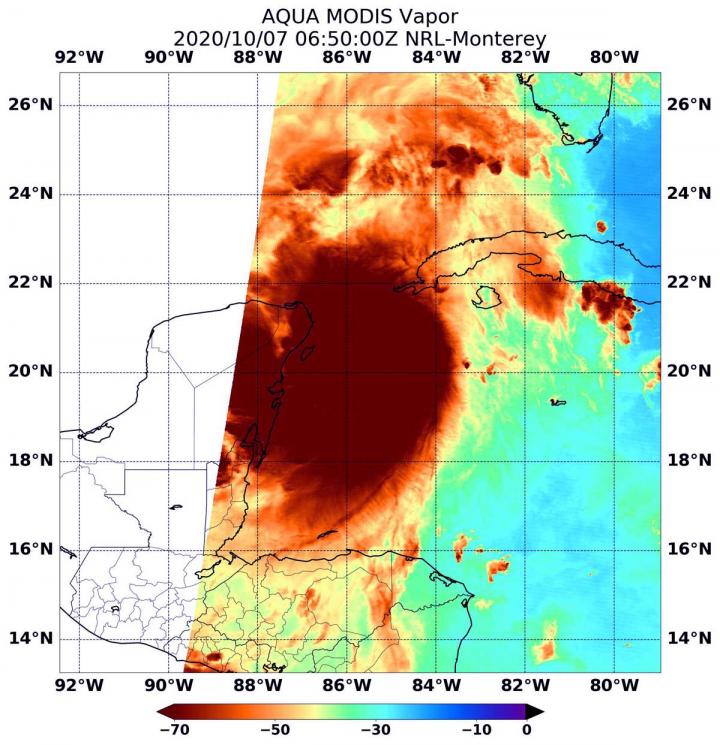
Credit: Credits: NASA/NRL
When NASA’s Aqua satellite passed over the Caribbean Sea on Oct. 7, it gathered water vapor data on Hurricane Delta as Mexico’s Yucatan continues to feel its effects.
Water vapor analysis of tropical cyclones tells forecasters how much potential a storm has to develop. Water vapor releases latent heat as it condenses into liquid. That liquid becomes clouds and thunderstorms that make up a tropical cyclone. Temperature is important when trying to understand how strong storms can be. The higher the cloud tops, the colder and stronger the storms.
NASA’s Aqua satellite passed over Delta on Oct. 7 at 2:50 a.m. EDT (0650 UTC), and the Moderate Resolution Imaging Spectroradiometer or MODIS instrument gathered water vapor content and temperature information. NASA’s Aqua satellite is one in a fleet of NASA satellites that provide data for hurricane research.
The MODIS image showed highest concentrations of water vapor and coldest cloud top temperatures were around the center of circulation and east of the center. Strongest storms were over the northern Caribbean Sea, between Mexico’s Yucatan Peninsula and western Cuba. MODIS data also showed coldest cloud top temperatures were as cold as or colder than minus 90 degrees Fahrenheit (minus 67.7 degrees Celsius) in those storms. Storms with cloud top temperatures that cold have the capability to produce heavy rainfall.
At 5 a.m. EDT, NHC Senior Hurricane Specialist Eric Blake said, “Satellite images show very deep convection associated with Delta, with extremely cold cloud-top temperatures to minus 97 degrees Celsius noted southwest of the center overnight. However, this structure has not resulted in a stronger cyclone, and the full NOAA Hurricane Hunter aircraft mission actually indicated that Delta has significantly weakened since earlier today.”
Forecasters at the National Hurricane Center (NHC) noted, “Through early Thursday, Delta is expected to produce 4 to 6 inches of rain, with isolated maximum totals of 10 inches, across portions of the northern Yucatan Peninsula. This rainfall may result in areas of significant flash flooding. In addition, 2 to 4 inches of rain, with isolated higher amounts, are expected across portions of western Cuba. This rainfall may result in areas of flash flooding and mudslides.”
Warnings and Watches on Oct. 7
NHC issued a Hurricane Warning from Tulum to Dzilam, Mexico and for Cozumel. A Tropical Storm Warning is in effect for the Cuban province of Pinar del Rio; from Punta Herrero to Tulum, Mexico; and from Dzilam to Progreso, Mexico.
Delta’s Status on Oct. 7
At 8 a.m. EDT (1200 UTC), the NHC said the center of Hurricane Delta was located by satellite images and surface observation inland over northeastern Mexico near latitude 21.1 degrees north and longitude 87.4 degrees west. Delta was centered just 35 miles (55 km) west of Cancun, Mexico.
Delta was moving toward the northwest near 17 mph (28 kph). A west northwestward-to-northwestward motion is expected over the next day or so. A slower northwestward to north-northwestward motion is forecast to begin on Thursday, and a northward motion is likely Thursday night and Friday. Maximum sustained winds are near 105 mph (165 kph) with higher gusts. The estimated minimum central pressure based on surface observations is 974 millibars.
Delta’s Forecast Track
NHC forecasters said, “Although some additional weakening is likely when Delta moves over the Yucatan peninsula this morning, re-strengthening is forecast when the hurricane moves over the southern Gulf of Mexico Wednesday night and Thursday, and Delta could become a category 4 hurricane again by late Thursday. Weakening is expected as Delta approaches the northern Gulf coast on Friday.
On the forecast track, Delta is expected to move over the southern Gulf of Mexico during the afternoon of Oct. 7 and be over the southern or central Gulf of Mexico through Thursday. Delta is expected to approach the northern Gulf coast on Friday, Oct. 9.”
NASA Researches Tropical Cyclones
Hurricanes/tropical cyclones are the most powerful weather events on Earth. NASA’s expertise in space and scientific exploration contributes to essential services provided to the American people by other federal agencies, such as hurricane weather forecasting.
For more than five decades, NASA has used the vantage point of space to understand and explore our home planet, improve lives and safeguard our future. NASA brings together technology, science, and unique global Earth observations to provide societal benefits and strengthen our nation. Advancing knowledge of our home planet contributes directly to America’s leadership in space and scientific exploration.
For NHC’s Key Messages, visit: http://www.
By Rob Gutro
NASA’s Goddard Space Flight Center
###
Media Contact
Rob Gutro
[email protected]
Original Source
https:/




